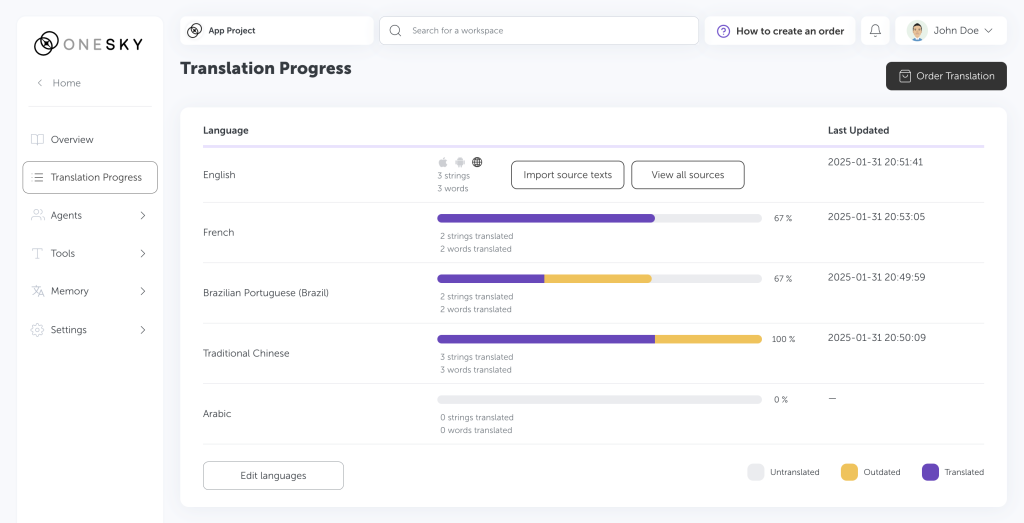Global growth relies on localization, but traditional methods are slow and costly. Using AI-powered multi-agent systems to offer quick, exact translations at half the cost of human services, OneSky Localization Agent is redefining the game. OneSky aims to make AI localization easy and effective by using automation, human oversight, and smooth integration into development processes. Founder Jac Wong explains how the business is changing the industry.
1. What inspired the creation of the OneSky Localization Agent, and how does it address the challenges businesses face in global localization?
Jac Wong: Many businesses recognize the rise of AI and seek any chance to use it as a cost-effective way to expand into global markets. They realize that localization is the key, and now is an opportunity to have significant cost savings in the AI era. However, concerns about the quality of AI translations often lead to hesitation and anxiety when they adopt AI localization solutions.
OneSky Localization Agent was created to resolve this pain point. It covers both pre-translation and translation phases to achieve the highest AI translation quality. It preprocesses strings before they enter the AI translation process, orchestrated by CoFluent AI, and serves as the translation engine for the OneSky Localization Agent.
2. OneSky Localization Agent uses multiple LLMs and AI agents to deliver superior translations. Can you elaborate on how this system works?
Jac Wong: Unlike translation using a single LLM prompt, CoFluent AI employs a collaborative multi-agent system to deliver translations. The process begins with string provisioning. Taking app strings as an example, this step preserves formatting such as placeholders and variables and maintains metadata like character length limits and string differences. When all strings are in the proper shape, each AI agent plays a specific role, such as translator, voter, proofreader, or quality evaluator, to do their job. We show their thought processes, interactions, and outputs. These agents collaborate and cross-verify each other’s work to ensure translations are both accurate and contextually relevant.

3. How does your Human-in-the-Loop approach enhance the quality and reliability of AI translations?
Jac Wong: We aim to achieve 100% human-like fluency with human involvement occurring at two key stages, which are upstream and downstream Human-in-the-loop. Upstream is before translation, human AI specialists and linguistic evaluators fine-tune the configurations of the multi-agent system. Downstream is after translation; human linguists review flagged translations for assurance. Our long-term goal is to focus on the upstream stage and eliminate the need for the downstream stage as AI technology advances. While OneSky Localization Agent delivers over 90% human-like results, we still want our customers to have the option to ensure every translation meets the highest quality standard. That’s why we offer human post-editing services.
4. What feedback have you received from customers about achieving 100% human-like translation results while saving costs?
Jac Wong: Customers have praised OneSky Localization Agent for its cost-effectiveness and scalability, which help reduce translation expenses by 50% compared to traditional human translation services while maintaining top-tier quality. Developers appreciate the seamless integration into their localization workflows, which allows them to reduce development and maintenance costs and launch products faster to international markets.
5. Localization involves various industries and content types. How does OneSky Localization Agent adapt to diverse requirements?
Jac Wong: Yes, there are various types, and one of the most complicated is software localization because it involves additional programming procedures that other types don’t require. We are developers who understand the development cycle very well. We specialize in software translations for mobile, gaming, and web apps, partnering with an extensive network of over 1,000 professional linguists who have collaborated with OneSky for more than a decade. Also, our system has built-in integrations to support popular tools for app development, including GitHub, GitLab, and Bitbucket, so users can localize their products without disrupting existing operations.
6. How does OneSky Localization Agent streamline workflows for product managers and developers?
Jac Wong: Product managers can interact with AI agents. All they need to do is sign off on their decisions, share their preferences, and delegate tasks to the agents. By providing a quick brief, they’ll receive human-like translations. On the technical side, we simplify localization with automation tools, API integrations, and CLI support, allowing developers to integrate automated localization workflows into their development cycles.

7. What sets OneSky Localization Agent apart from other localization solutions in terms of scalability and ease of integration?
Jac Wong: Unlike traditional translation services or single LLM AI solutions, our translation engine, CoFluent AI, uses a multi-agent approach, which enables high-quality translations at scale. Our autonomous AI agents minimize in-house translator management efforts, allowing users to delegate tasks entirely to the agents. Integrating with other platforms while maintaining control over content, context, and order processes within localization workflows reduces the technical burden, making AI adoption simple for companies of all sizes.
8. Can you share a success story where a OneSky Localization Agent transformed a client’s global market entry?
Jac Wong: One of our clients, a global SaaS company, needed to localize their product into multiple languages quickly without increasing operational costs. By integrating the OneSky Localization Agent, they achieved over 90% human-like translations automatically, with post-editing available for critical content. This accelerated their market entry, reduced costs by over 50%, and enabled them to scale localization without hiring additional staff. The client now relies on our product as a core part of their expansion strategy for continuous localization.
9. What challenges have you faced in developing and scaling OneSky Localization Agent, and how did you overcome them?
Jac Wong: One of the biggest challenges was gaining user trust in AI translation quality. To overcome this, we focused on continuous AI training and human evaluation, ensuring that our AI system consistently produces top-tier results. Another challenge is the adoption of AI agents, which is still seen as an innovative approach in the B2B sector. To address this, we begin by targeting innovators and early adopters who are more receptive to emerging trends, especially in the technology industry.
10. What personal sacrifices or pivotal decisions have shaped your journey in building OneSky Localization Agent?
Jac Wong: Transitioning from traditional translation services to AI localization agents was a bold move that required extensive research, significant investment, and a willingness to challenge industry norms. This evolution opened up a blue ocean of opportunities, and we felt it was the right time to dive in. We didn’t want to be late to the game. With the advent of more advanced LLMs and increased competition driving down costs, our research team began to break through quality barriers at the reasoning layer. Building a cognitive architecture led to substantial improvements, signaling that the time was right for us to fully embrace this approach.
11. What does success look like for you and OneSky Localization Agent in the next 3–5 years?
Jac Wong: Our vision is to establish fully autonomous AI localization, where users can delegate the entire process to AI with minimal human intervention, and it’s easier than ever. We believe that AI localization agent will become a major approach in the near future, due to its seamlessly integration with other functional agents. We can see that the trend is on the rise, and we look forward to being a leader in this area.
12. What does a typical day in your life as a founder look like, and how do you stay motivated?
Jac Wong: There are always ups and downs as a startup founder. To handle this, I always prepare for worst-case scenarios. Once that’s in place, I stay optimistic to focus on planned strategies and follow a daily routine of action items while letting feedback guide my next steps. My day is a mix of strategy execution and customer engagement. Since our company is fully remote, I wake up early to join calls with teams in different time zones. I’m motivated by the progress we’re making in our vision.
Editor’s Note:
Jac Wong is addressing key issues in global localization, instead of just making another AI translation tool. OneSky goes beyond basic AI translation by using organized methods, quality checks, and easy-to-use connections for developers. What is the goal? Make localization perfect so companies can easily expand abroad. If OneSky is successful, using AI for location will become normal and expected.



